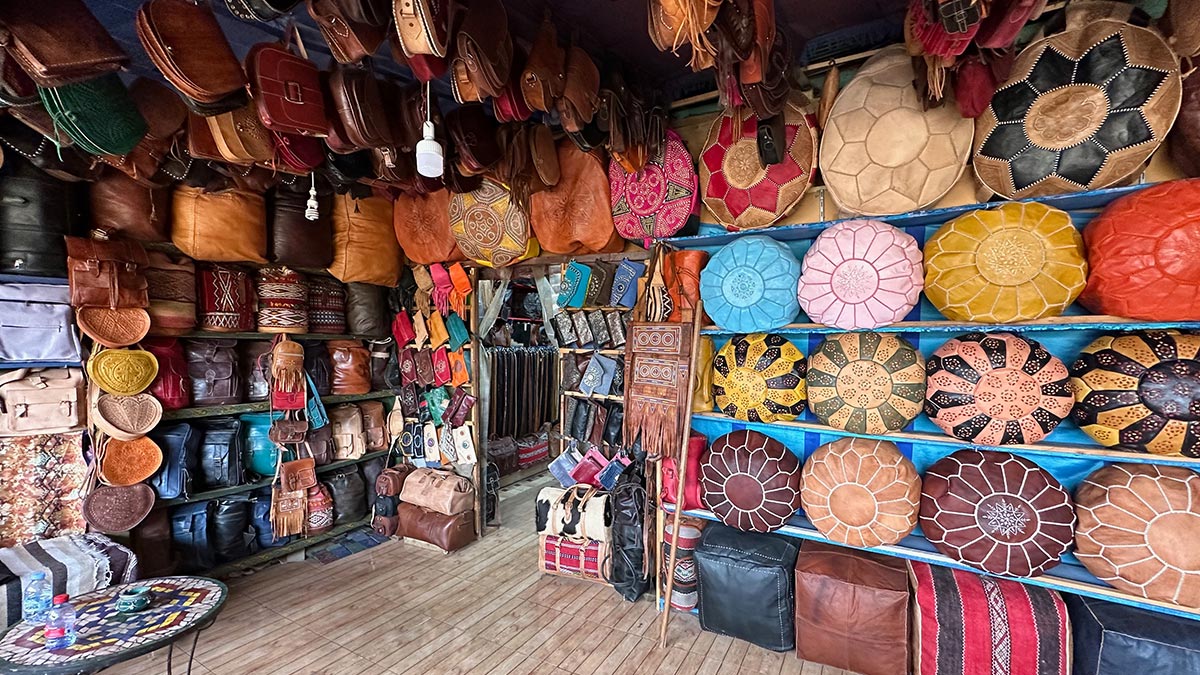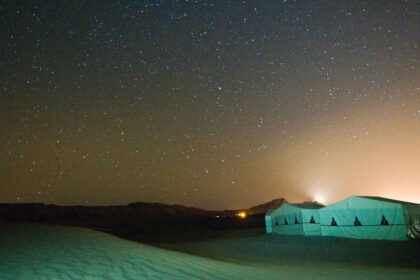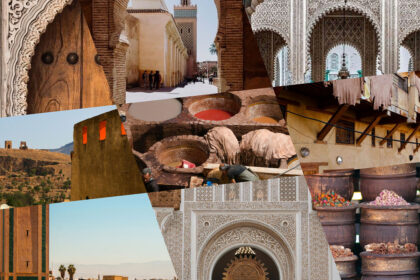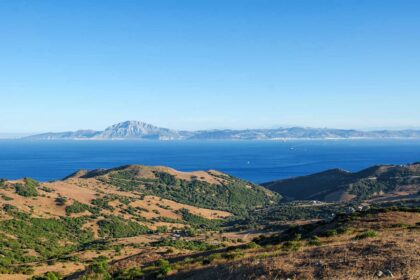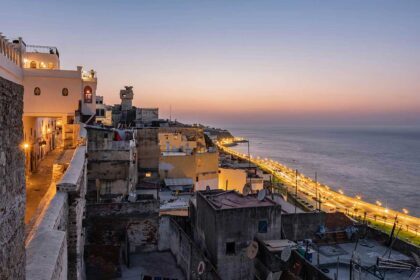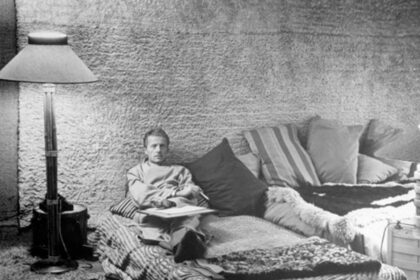Are you tired of boring shopping malls and cookie-cutter stores? Do you crave a real adventure while you shop?
- Understanding Fez Medina Souks
- Navigating the Maze of Fes
- Must-Visit Souks in Fez Medina
- Shopping Tips and Etiquette
- What to Buy in Fez Medina Souks
- Avoiding Common Scams
- Best Times to Visit Fez Souks
- Food and Refreshments in the Souks
- Beyond Shopping: Experiencing the Souk Atmosphere
- Guided Tours vs. Independent Exploration
- Conclusion
Imagine getting lost in a maze of narrow alleys. The air is filled with exotic smells and the sound of haggling. Colorful rugs and shiny lamps hang from every doorway. This isn’t a dream. It’s the Fez Medina Souks in Morocco!
But there’s a problem. Many tourists feel overwhelmed by the Souks in Fes. They worry about getting lost or being scammed. Some even skip this amazing experience because they’re unsure what to do in Fez.
Don’t let fear stop you from exploring this magical place! With the right tips, you can shop like a pro in the Fez Medina Souks.
In this blog post, we’ll solve the mystery of the souks for you. We’ll show you how to navigate the winding streets and find the best deals. You’ll learn what to buy, how to bargain, and where to find the coolest spots.
The Fez Medina Souks are more than just a place to shop. They’re a window into Moroccan culture and history. Every corner has a story to tell. Did you know that some of these souks have been around for over 1,000 years? Or that you can watch skilled artisans make leather goods and pottery right before your eyes?
Shopping in the Fez Medina Souks is one of the top things to do in Fez. It’s a must-have experience for any traveler who wants to really understand Morocco. So, are you ready to dive into the heart of Fez? Let’s explore the twisting alleys, vibrant stalls, and hidden gems of the Fez Medina Souks together. Get ready for a shopping adventure like no other!
Understanding Fez Medina Souks
Souks are traditional Arab markets. They’ve been around for centuries! In Fez, these markets are the heart of the old city. The word “souk” comes from Arabic. It means “marketplace.” Souks in Fez date back to the 9th century when the city was founded. These markets were more than just places to shop. They were centers of trade, culture, and social life. People came from far and wide to buy and sell goods.
Today, the souks in Fez still buzz with energy. They’re a living piece of history you can explore and enjoy.
The Fez Medina souks can seem like a maze. But there’s a method to the madness! The souks are organized by what they sell. Each area focuses on specific goods. This setup has been the same for hundreds of years. Main streets run through the souks. Smaller alleys branch off from these. You’ll find shops and stalls lining both sides of these paths.
Some areas have covered roofs to keep out sun and rain. Others are open to the sky. It’s like a city within a city!
There are many types of souks in Fez Medina. Each one is special in its own way. The spice souk is a feast for your senses. Mounds of colorful spices fill the air with amazing smells. In the textile souk, you’ll see rolls of beautiful fabrics. Skilled weavers create stunning rugs and blankets here. The leather souk is famous for its tanneries. You can watch leather being made and buy amazing leather goods.
There are also souks for metalwork, pottery, and woodcarving. Each one shows off the skills of local craftspeople. Don’t forget about the food souks! Here, you can taste fresh bread, olives, and other Moroccan treats. Every souk in Fez has its own character. Exploring them all is like going on a treasure hunt!
Navigating the Maze of Fes
The souks can be confusing, but don’t worry! Here are some tips to help you find your way:
- Look for the sun. It can help you figure out which direction you’re going.
- Pay attention to the shops around you. Each area sells different things, so this can help you know where you are.
- When you see a big street, remember it. These main roads can help you get back on track if you get lost.
- Don’t be afraid to ask for help. Most shopkeepers are friendly and can point you in the right direction.
Some places in the souks stand out. Remember these to help you find your way:
- The Kairaouine Mosque is in the middle of the medina. Its tall minaret is easy to spot.
- Look for the famous blue gate, Bab Boujloud. It’s at the west end of the medina.
- The Place Seffarine is a small square where metalworkers make things. You can hear the sound of hammering from far away.
- The tanneries are smelly but important. If you smell leather, you might be near them.
Using a map or guide in Fes
A map can be really helpful in the souks. You can buy one at most bookstores in Fez. Some people like to use their phones for maps. But be careful – the tiny streets can confuse GPS sometimes.
If you’re worried about getting lost, you might want to hire a guide. Official guides know the souks well and can show you around. You can also ask your hotel for a simple map. They often have ones that show the main areas of the souks.
Remember, getting a little lost is part of the fun in the souks. Don’t stress too much about always knowing exactly where you are!
Must-Visit Souks in Fez Medina
1. Souk el-Attarine (Spice and Perfume Souk)
Souk el-Attarine is a treat for your nose! This souk is full of spices and perfumes. You’ll see piles of colorful powders everywhere. These are spices like turmeric, cumin, and saffron. The air smells sweet from all the perfumes. You can buy scented oils and soaps here too. Don’t forget to try some Moroccan tea blends. They’re a tasty souvenir to take home.
2. Souk el-Henna (Henna and Cosmetics Souk)
Souk el-Henna is all about beauty. It’s where locals go for henna and makeup. You’ll see lots of henna powder and paste. Some shops will even do henna designs for you. There are also natural beauty products. Look for argan oil – it’s great for skin and hair. You might spot traditional kohl eyeliner too. It’s been used in Morocco for hundreds of years.
3. Souk el-Draz (Textile Souk)
Souk el-Draz is a rainbow of fabrics. It’s where you’ll find all kinds of textiles. Watch weavers make rugs on big looms. It’s amazing to see how fast they work! You can buy beautiful scarves and blankets here. The colors and patterns are stunning. Don’t miss the traditional Moroccan caftans. They’re long, flowing robes worn by both men and women.
4. Souk el-Seffarine (Metalwork Souk)
Souk el-Seffarine is noisy but exciting. It’s where metalworkers make pots, pans, and more. You’ll hear the sound of hammering all around you. Watch as craftsmen shape metal by hand. Look for shiny brass trays and teapots. They’re popular souvenirs from Morocco. You might even see someone making a tagine pot. These are used to cook tasty Moroccan stews.
5. Souk el-Nejjarine (Carpenter’s Souk)
Souk el-Nejjarine is all about wood. It’s where carpenters show off their skills. You’ll see beautiful wooden furniture being made. Watch as artisans carve intricate designs. Look for small wooden boxes with pretty patterns. They’re perfect for holding jewelry. Don’t miss the Nejjarine Museum nearby. It’s in an old fondouk, or inn, and shows off lots of woodwork.
Shopping Tips and Etiquette
Bargaining techniques and expectations
Bargaining is normal in the souks. It’s not rude – it’s part of the fun! Start by offering about half the asking price. The seller will then suggest a lower price. Keep going back and forth until you agree. If you can’t agree, it’s okay to walk away.
Remember to be polite and smile. Bargaining should be friendly, not angry. Don’t start bargaining unless you’re serious about buying. It’s not fair to the sellers.
Quality assessment of products
Take your time to check things before you buy. Look closely at the items you want. For textiles, feel the fabric. Good quality should feel thick and well-made. With metal items, check for any dents or scratches. Make sure moving parts work well. For spices, smell them. Fresh spices have a strong, nice smell. If you’re not sure, ask the seller questions. Most are happy to tell you about their products.
Cultural sensitivities and photography rules
- Always ask before taking photos of people or shops. Some folks don’t like having their picture taken.
- Dress modestly when shopping. Cover your shoulders and knees to show respect.
- Be extra careful around mosques. Some areas are off-limits to non-Muslims.
- Don’t eat or drink in public during Ramadan. It’s a time when many people are fasting.
- Remember that Friday is a holy day. Some shops might be closed or open later.
Payment methods and currency tips
Most sellers in the souks prefer cash. The local money is called the Moroccan dirham. You can exchange money at banks or official exchange offices. Avoid changing money on the street. Some bigger shops might take credit cards. But it’s best to have cash for most places.
Keep your money safe. Use a money belt or keep your wallet in a front pocket. Check your change carefully. Sometimes sellers might make mistakes. Try to use small bills when you can. Many small shops don’t like breaking big bills.
What to Buy in Fez Medina Souks
Traditional Moroccan crafts
The souks are full of amazing crafts. You’ll find things you can’t get anywhere else. Look for colorful poufs. These are round cushions used for sitting on the floor. Moroccan lamps are very popular. They cast beautiful patterns on the walls when lit. You might also see babouche slippers. These pointy leather shoes are comfy and cute.
Don’t forget about wooden boxes with inlaid designs. They’re great for storing small items.
Textiles and carpets
Moroccan textiles are famous for good reason. The colors and patterns are stunning. Carpets are a big deal here. You’ll see all kinds, from small prayer rugs to huge room-sized ones. Look for soft blankets called handiras. They’re often used as wedding blankets. Scarves and shawls are easy to pack and make great gifts. You’ll find them in silk and cotton.
Spices and food items
The spice souk is a must-visit. You’ll find spices you’ve never seen before. Ras el hanout is a popular spice mix. It’s used in lots of Moroccan dishes. Saffron from Morocco is some of the best in the world. A little goes a long way. Look for argan oil too. It’s great for cooking and for your skin. Don’t forget about Moroccan tea and dates. They make tasty souvenirs.
Leather goods
Fez is famous for its leather. You’ll find all sorts of leather items in the souks. Bags and purses come in many styles. From simple to fancy, there’s something for everyone. Leather jackets and shoes are also popular. They’re often handmade and very sturdy. You might even see leather-bound books or notebooks. They make great gifts.
Ceramics and metalwork
Moroccan ceramics are known for their bright colors and patterns. Look for plates, bowls, and tagines. You’ll also see lots of metalwork. Brass and copper items are very common. Tea sets are a popular buy. They often come with a tray, teapot, and small glasses. Don’t miss the big metal lanterns. They look amazing when lit up at night. Some shops sell metal wall hangings too. These can add a Moroccan touch to any room.
Avoiding Common Scams
Fake guides and touts
Watch out for people who offer to be your guide. Some aren’t real guides at all. These fake guides might try to take you to specific shops. They often get a cut of what you buy. If you want a guide, ask your hotel to recommend one. Or look for guides with official badges.
It’s okay to say “No, thank you” to anyone who bothers you. You don’t have to be nice to pushy people.
Quality misrepresentation
Some sellers might try to trick you about what they’re selling. They might say something is better than it is. For example, they might claim a rug is pure silk when it’s really a mix. Or say something is antique when it’s new.
Ask lots of questions about what you’re buying. If something seems too good to be true, it probably is. Trust your gut. If you’re not sure about something, it’s okay to walk away.
Price inflation for tourists
Some shops have much higher prices for tourists. This is pretty common in busy areas. To avoid this, try to shop where locals shop. These places often have fairer prices. It helps to know roughly how much things should cost. Ask at your hotel or check online before you shop.
Remember, it’s okay to bargain. Don’t be afraid to ask for a lower price.
How to politely decline unwanted attention
Sometimes, sellers can be very pushy. It’s okay to be firm when saying no. You can say “La shukran,” which means “No, thank you” in Arabic. This often works well. If someone keeps bothering you, it’s fine to ignore them and walk away. You don’t owe them your time. Don’t feel bad about leaving a shop if you’re uncomfortable. Your safety and comfort come first.
Remember, most people in the souks are honest. But it’s smart to be careful and trust your instincts.
Best Times to Visit Fez Souks
Daily opening hours
Most shops in the souks open around 9 or 10 in the morning. They usually close late, often after 8 PM. Some shops close for a few hours in the afternoon. This is when it’s hottest outside.
Food stalls and restaurants often stay open later. You can find food until late at night.
Remember, Friday is a holy day. Many shops open later or close early on Fridays.
Seasonal considerations
Spring and fall are great times to visit. The weather is nice and not too hot. Summer can be very hot in Fez. If you visit then, shop in the early morning or evening.
Winter is cooler and can be rainy. But there are fewer tourists, so the souks are less crowded.
During Ramadan, many shops have different hours. They might open later and close early.
Avoiding peak tourist times
The souks are busiest in the late morning and afternoon. Try to shop early or later in the day. Weekends are often more crowded than weekdays. Monday to Thursday are usually quieter.
The souks get very busy during major holidays. This includes both Moroccan and Western holidays. Try to avoid the peak tourist season of July and August. The souks are very crowded then. Early spring or late fall can be perfect. You’ll have good weather and fewer crowds.
Remember, even during busy times, you can find quiet spots. Just wander off the main paths a bit.
Food and Refreshments in the Souks
Traditional street food options
The souks are full of yummy smells from street food. You’ll find lots of tasty snacks to try. Look for stalls selling freshly baked bread. It’s often still warm and smells great.
You might see people selling sfenj, which are Moroccan donuts. They’re crispy and sweet. Grilled meat skewers are popular too. They’re often served with bread and a spicy sauce.
Don’t miss the fresh fruit stands. You can buy oranges, dates, and figs to snack on as you walk.
Cafes and restaurants in and around the souks
If you want to sit down and eat, there are lots of options. You’ll find small cafes tucked away in the souks. Many serve Moroccan mint tea. It’s very sweet and refreshing on a hot day.
For a bigger meal, look for restaurants near the main squares. They often have traditional Moroccan food. Try a tagine if you can. It’s a slow-cooked stew that’s full of flavor. Some places have roof terraces where you can eat. These offer great views of the medina.
Safety tips for eating in the souks
When eating street food, look for busy stalls. If lots of locals are eating there, it’s usually a good sign. Make sure any meat is cooked well. It should be hot all the way through.
Stick to bottled water to be safe. Avoid drinks with ice unless you’re sure it’s made with clean water.
Wash your hands before eating if you can. Some cafes have sinks you can use.
If you have a sensitive stomach, start with simpler foods. Plain bread or grilled vegetables are good choices. Don’t be afraid to try new things, but trust your instincts. If something doesn’t look right, it’s okay to skip it.
Remember, eating in the souks is part of the fun. Just be smart and you’ll have a great time trying new foods!
Beyond Shopping: Experiencing the Souk Atmosphere
People-watching opportunities
The souks are great places to watch people. You’ll see all kinds of interesting things. Find a cafe and sit for a while. Watch as locals go about their daily shopping. Look for the mix of old and new. You might see someone in traditional clothes next to someone in jeans.
Listen to the sounds around you. You’ll hear a mix of languages and the calls of sellers. Notice how people interact. Bargaining isn’t just about money – it’s a social activity too.
Artisans at work
Many shops in the souks are also workshops. You can often see artisans making things. Watch weavers creating rugs on big looms. Their hands move so fast it’s hard to follow.
In the metal souk, you’ll see smiths hammering out pots and pans. The sound is loud but exciting.
Look for leather workers sewing bags and shoes. They use techniques passed down for generations.
Some wood carvers let you watch as they make intricate designs. It takes a lot of skill and patience.
Historical and architectural points of interest
The souks are full of history. Many buildings have been there for hundreds of years. Look up to see the beautiful archways. Some have intricate designs carved into the stone. Notice the old doors. Many are huge and have interesting knockers or designs.
Some areas have covered roofs that are centuries old. They keep the streets cool and shaded. Keep an eye out for old fountains. These used to be the main source of water for the neighborhood. You might spot small shrines tucked away in corners. These are important to local people.
Remember, the souks aren’t just for shopping. They’re living museums of Moroccan culture and history.
Guided Tours vs. Independent Exploration
Pros and cons of each approach
Guided tours can be helpful in the souks. A good guide knows the area well and can share lots of info. With a guide, you’re less likely to get lost. They can also help you bargain and avoid scams.
But guided tours can be pricey. You might also feel rushed or miss things you want to see. Exploring on your own is free and lets you go at your own pace. You can spend as much time as you want in each place.
Independent exploration lets you discover hidden spots. You might find cool things a tour would skip. The downside is you might get lost or miss important sights. It can also be harder to learn about what you’re seeing.
Recommendations for reputable guided tours
Look for tours recommended by your hotel or trusted travel websites like Must Visit Morocco. They often know good guides. Official guides should have a badge from the Moroccan tourism board. Ask to see this before you start.
Some popular tour companies are Mint Tea Tours and Guide In Fes. They have good reviews.
Half-day tours are often enough to see the main sights. Full-day tours can be tiring. Food tours are fun if you like trying new things. They’ll take you to good spots to eat.
Tips for successful independent exploration
- Get a good map of the medina. Your hotel might have one, or you can buy one in town.
- Start your walk from a main gate or a big landmark. It’s easier to find your way back.
- Don’t be afraid to ask for directions. Most people are happy to help if you’re polite.
- Take breaks when you need to. Find a cafe to rest and watch the world go by.
- Keep track of where you’ve been. You might want to drop pins on your phone map.
- Be open to getting a little lost. Some of the best experiences happen when you wander off the main paths.
- Remember, there’s no right or wrong way to explore. Choose what feels best for you and have fun!
Conclusion
The Fez Medina souks are amazing places. They’re full of colors, smells, and sounds you won’t find anywhere else. You can buy all sorts of things here. From spices to carpets to leather goods, there’s something for everyone.
The souks are more than just shops. They’re a living piece of Moroccan history and culture. Walking through the souks is like stepping back in time. But you’ll also see how modern life mixes with tradition.
Remember, every trip to the souks is different. You never know what amazing things you might find or experience!







